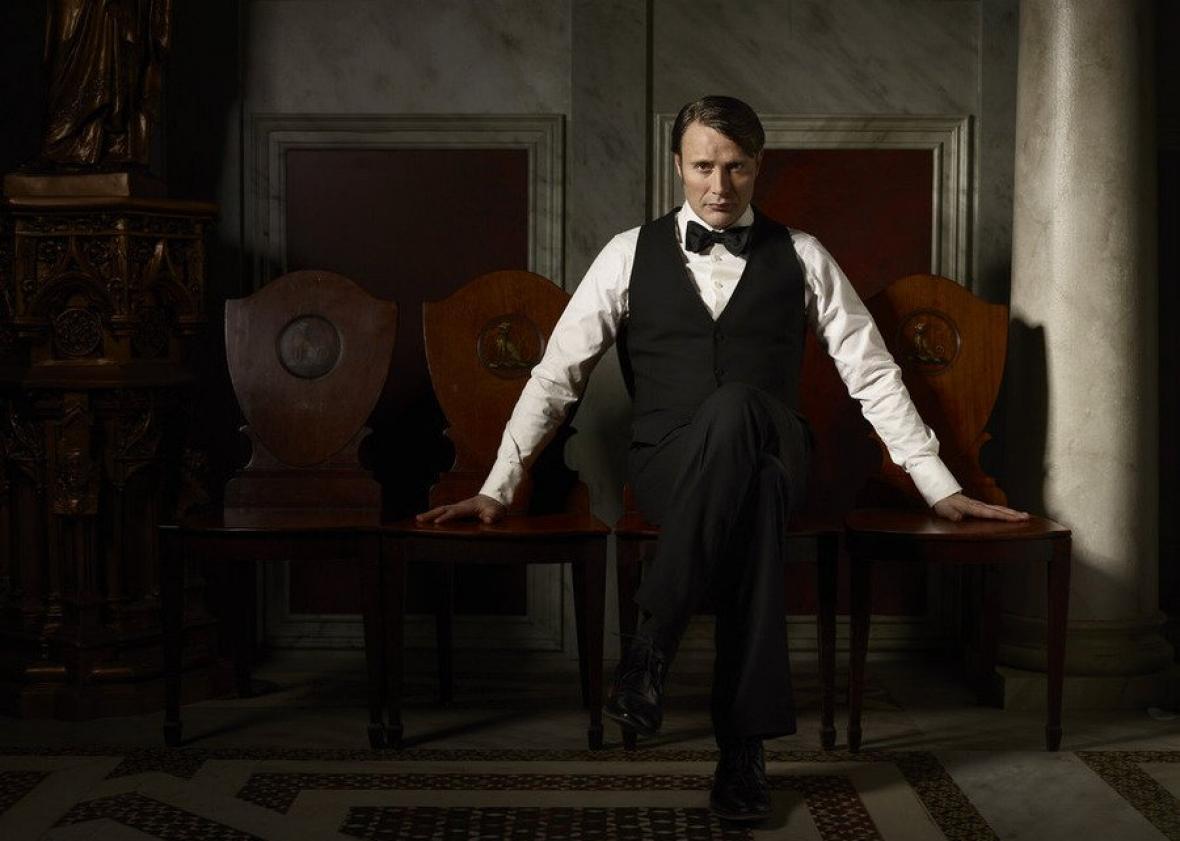NBC’s Hannibal, which airs its final episode Saturday, will be remembered for many reasons. It offered a sly twist on the standard network crime drama. It helped elevate the careers of its stars, Mads Mikkelsen and Hugh Dancy. It’s proven to be one of the most formally innovative, groundbreaking shows on television. And it’s a prime example of how to do adaptation well.
For a while, it was a cliché in writing about Hannibal to express surprise that it was any good, precisely because the underlying story has been told so many times—first in Thomas Harris’ novels, then the Hannibal Lecter movies. The cannibal psychiatrist had become a dead caricature of himself, until showrunner Bryan Fuller resurrected him and made him scarier than ever before. When the credits during each episode flash “based on the characters from the book Red Dragon by Thomas Harris,” it’s almost a challenge, asking the viewer to contend with the fact that something so original has such long roots. How did one of the best, freshest shows of the past few years come out of something so old?
In part, the show is so successful because it takes great liberties with the Lecter “canon.” Rather than quickly catching Hannibal, investigator Will Graham (Dancy) forms a close, painfully intimate bond with him that gives the show an emotional spine. It’s an element that isn’t so much a part of the books, where Hannibal and Graham have a connection mostly based on a shared understanding of human monstrosity. And it’s why the second season of Hannibal is a near-perfect run of television, capturing the iconography and themes of the films while devising new and surprising plots. The show wasn’t just telling a new story; it was asking us how we felt about the old one.
Fuller and the rest of the Hannibal team treated Harris’ novels the way a more liberal church might treat the Bible: as a rough series of rules for how to live, how to eat, and, occasionally, how to punish sinners, rather than heavenly commandments deserving of literal, exacting, textual adherence.
Harris’ novels and their original film adaptations helped define and redefine the serial killer genre, painting portraits of twisted psyches in blood and sweat. Like the best monster stories, they’re flexible enough to be imbued with the spirit of new times. So not only does Fuller’s visual aesthetic direct us toward tiny moments like a floating drop of blood or a ring falling through water, the show sees old events through new eyes. Where Harris’ novels emphasize the general indecency and deviancy in his killers, and where the Academy Award-winning Silence of the Lambs is startlingly open with its transphobia, Hannibal treats human bodies and everything they can do as beautiful, and ultimately has a surprising central theme for a story about murder: love.
Going into the show, we knew where Hannibal and Will would end up, roughly. What we didn’t know, in this version of events, and what Fuller gave us, is why. The answer, as fans have known for some time, and as Will explicitly recognizes in a therapy session in the penultimate episode, is, in fact, love. The skeleton of Hannibal is a story about two men who don’t fit into the rest of the world and find each other—the rest is delicious, but ultimately unnecessary flesh.
But the very shift that allows Hannibal to tell such a different version of Red Dragon—the decision to aggressively prequelize—did have its drawbacks when the time came to adapt Harris, specifically through the character of the Red Dragon himself. With so much time, energy, and gore invested in Will and Hannibal and their relationship, elevating Francis Dolarhyde as their equal is a tall order, and, as talented as Richard Armitage is, he was never enough of a presence to meddle with the enormous gravitational field drawing his counterparts together.
By the end of the Red Dragon arc, Hannibal started to fall into the little Tetris games that characterize most adaptations: The pieces still have to fit together, but watching the writers figure out exactly how becomes a bit of a chore. Instead of tabloid reporter Freddie Lounds being burned alive in a wheelchair for the crime of writing about the Dragon, Frederick Chilton finds himself on the business end of Dolarhyde’s lighter. “Oh,” a clever viewer might say. “I see what they did there.” The fact that the finale got me one last time, somehow briefly tricking me into believing that the series had eschewed one of the more iconic plot twists from Red Dragon, is a testament to how good—and genuinely surprising—the show has been.
Adaptations of previously existing material allow networks to bring in a previously existing audience, which is presumably why we are seeing so many of them. Game of Thrones viewers have made a semi-professional sport out of parsing the smallest differences between the worlds on the page and on the screen. Coming up we’ll have HBO’s Westworld, Hulu’s 11/22/63, and Fuller’s own take on Neil Gaiman’s American Gods for Starz. SyFy’s fall line-up looks like a summer reading list, including adaptations of Les Grossman’s Magicians trilogy, The Expanse series, and Arthur C. Clarke’s Childhood’s End. And if, when it comes time to cut up the source material, they take the best pages out of Hannibal’s book, the series will have taught the TV landscape a valuable lesson: the art of beautiful cannibalism.
